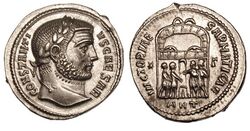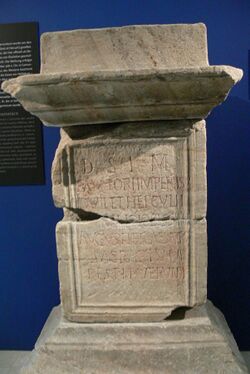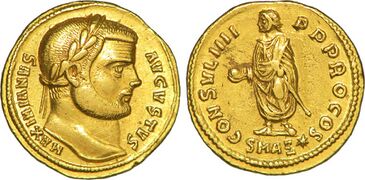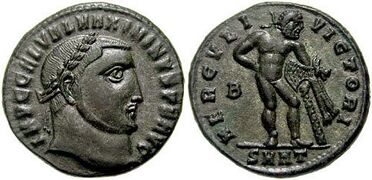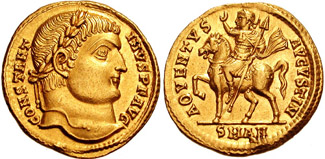Conference of Carnuntum
Topic: History
 From HandWiki - Reading time: 8 min
From HandWiki - Reading time: 8 min
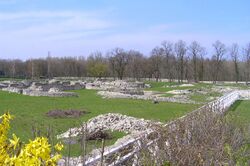 Ruins of Carnuntum | |
| Participants | Diocletian, Galerius, Maximian, Licinius |
|---|---|
| Location | Carnuntum, Austria, (ancient Panonnia Prima) |
| Date | November 11, 308 |
| Result | Inconclusive |
The Conference of Carnuntum (Latin: Carnuntum) was a military conference held on November 11, 308, in the city of Carnuntum (present-day Petronell-Carnuntum, Austria), which at the time was located in the province of Pannonia Prima. It was convened by the Augustus (senior Roman emperor) in the East Galerius (r. 293–311) as a way to settle the dispute over the title of Augustus in the West, and consequently, to cease the ongoing conflicts since the previous year when he, and before that Severus II (r. 305–307), invaded the Italy of Maxentius (r. 306–312) and Maximian (r. 286–308; 310). Present at the conference were Diocletian (r. 284–305), who had been retired since 305, and his former colleague, Maximian.
According to deliberations at the meeting, Maximian was to retire permanently from his imperial position; Licinius (r. 308–324), a former general of Galerius, was raised as the western Augustus and was to deal with Maxentius, who had been treated as an usurper; and Constantine (r. 306–337) was relegated, for the second time, to western Caesar. These decisions, however, did not please most of them: Constantine questioned his demotion and persisted in using the style of Augustus; Maximinus (r. 305–313) demanded promotion from Galerius; Maximian would not be satisfied with his demotion and would attempt one last conspiracy, in 310, at the court of Constantine in Arles, while Licinius would do nothing in the following years to stop Maxentius.
Background
Since 293, the Roman Empire had been governed by four emperors, a set of an Augustus (senior emperor) and a Caesar (junior emperor) for each of the western and eastern portions. On May 1, 305, the augusti Diocletian (r. 284-305) and Maximian (r. 285–308; 310) voluntarily abdicated and their caesares Constantius Chlorus (r. 293–306) and Galerius (r. 293–311) were elevated to the western and eastern augustal position respectively,[1] while Severus II (r. 305–307) and Maximinus Daza (r. 305–313) would become the western and eastern Caesars, respectively.[2][3][4]
In 306, Constantius Chlorus (r. 293–306), the western Augustus, died at Eboracum (present-day York, England ),[5] and his soldiers acclaimed his son Constantine the Great (r. 306-337) as his successor.[6] However, Galerius, the Augustus in the East (r. 293–311) elevates Severus II (r. 305–307) to the position of Augustus, since by the arrangement of the prevailing Tetrarchy, being the western Caesar, he was to succeed the dead Augustus. After some diplomatic discussions, Galerius relegated Constantine to the position of Caesar, which he accepted, thus allowing Severus to assume his position.[7]
Maxentius (r. 306–312), son of Maximian (r. 285–308; 310), was jealous of Constantine's elevation, and during a riot over capitation tax in Rome, a cohort of Praetorian guards acclaimed him emperor on 28 October 306, though at first he styled himself princeps invictus ("undefeated prince"), in the hope of obtaining recognition of his reign by the senior emperor Galerius. Then, uncomfortable with sole leadership, Maxentius sent a set of imperial robes to Maximian and saluted him as "Augustus for the second time", offering him theoretical equal rule but less actual power and a lower rank. [8] By 307, both had suffered invasions. The first by Severus II, who surrendered to Maximian, and after which, Maxentius finally assumed the style of Augustus. And then by Galerius himself, who ultimately decided to withdraw.[7] Before or during Galerius' invasion, Severus was executed or was forced to commit suicide.
Soon afterwards, Maximian made his way to Gaul to negotiate with Constantine. A deal was struck in which Constantine would marry Maximian's younger daughter Fausta and be elevated to Augustan rank in Maxentius' secessionist regime. In return, Constantine would reaffirm the old family alliance between Maximian and Constantius, and support Maxentius' cause in Italy but would remain neutral in the war with Galerius. The deal was sealed with a double ceremony in Augusta Treverorum (present day Trier, Germany ) in late 307, at which Constantine married Fausta and was declared Augustus by Maximian.[9] In 308, likely in April, Maximian attempted to depose his son in a failed plot, forcing him to flee Italy in disgrace, and eventually to Constantine's court in Gaul.[10] Aware of the situation in the west, Galerius decided to organize a conference, and Maximian pinned his hopes for re-ascension on it.[11]
Conference
On 11 November 308, Galerius convened the Conference of Carnuntum (now Petronell-Carnuntum, Austria) to try to stabilize the situation in the western provinces. Present at the conference were the retired emperor Diocletian, who briefly returned to public life, Galerius, and Maximian. At the conference, Maximian was forced to abdicate again, and Constantine was re-relegated to his former position as Caesar.[7]
In addition, Licinius, one of Galerius' military companions who was attending the conference, was acclaimed as the new Augustus in the West,[7] and was given the regions of Thrace, Pannonia, and Illyria, as well as the mission of neutralizing Maxentius in Italy.[12] Finally, the Augusti present rebuilt the Mithraeum of Carnuntum and dedicated it to the absent Caesars (Constantine and Maximinus Daza) and themselves:[13]
Fautori imperii sui Iovii et Herculii religiosissimi Augusti et Caesares
Sacrarium restitueruntFor the scholar A. L. Frothingham, considering that by the fourth century the cult of Mithras and the Sol Invictus was on the rise, it is not surprising that a dedication was made to these gods in the name of the emperors. According to him, this could be interpreted as a symbolic handing over of the state to these gods, who from that moment on would have the mission to guard it and prevent it from returning to the Crisis of the Third Century.[13]
- Augustus
Argenteus of Galerius (r. 293–311) issued at Thessaloniki c. 302
Solidus of Licinius (r. 308–324) issued in Nicomedia c. 317–318
- Caesars
Consequences
The new system would not last long: Constantine refused to accept his relegation and continued to portray himself as Augustus on his coinage, even though the other members of the Tetrarchy continued to refer to him as Caesar. Meanwhile, Licinius did nothing to remove the usurper Maxentius from power and preferred to deal with internal problems and barbarian incursions in the provinces vested in him.[12] Furthermore, Maximinus Daza, frustrated at being disregarded as a possible occupant of the position granted to Licinius, demanded a promotion from Galerius. Galerius offered to call both Maximinus and Constantine filii Augustorum ("sons of the Augustus", sing. filius Augustī),[14][15][16][17][18][19][20] a title they both refused. Between late 309 to the spring of 310, however, Galerius relented and called them each Augustus, which resulted in a situation of five full Augusti ruling the empire.[21][22]
In early 310, taking advantage of Constantine's absence on the Rhine frontier fighting against Frankish invaders, Maximian revolted at Arelate (present-day Arles, France ) and tried to take his position. He would gain little support for the revolt and soon Constantine would become aware of what had occurred. He immediately headed south and easily quelled the revolt, capturing Maximian and encouraging him to commit suicide.[11][23][18][24][25][26][27] The following year, Maxentius, calling for revenge for his father's death, declared war on Constantine, who responded with an invasion of northern Italy in 312.[28][29] In the same year, Galerius died and the Eastern Roman Empire is divided between Maximinus and Licinius, who after some disagreements, decided to sign a peace in 312 on the Bosphorus. It would be short-lived, with them declaring war on each other by 313.[7][30]
See also
- Carnuntum
- Petronell-Carnuntum
- Roman Empire
References
- ↑ Potter, D. S. (2004). The Roman Empire at bay : AD 180-395. London: Routledge. pp. 342. ISBN 0-415-10057-7. OCLC 52430927. https://www.worldcat.org/oclc/52430927.
- ↑ Barnes, Timothy David (1981). Constantine and Eusebius. Cambridge, Mass.: Harvard University Press. pp. 25–27. ISBN 0-674-16530-6. OCLC 7459753. https://www.worldcat.org/oclc/7459753.
- ↑ Williams, Stephen (1997). Diocletian and the Roman recovery (1st ed.). New York: Routledge. pp. 191. ISBN 0-415-91827-8. OCLC 35008231. https://www.worldcat.org/oclc/35008231.
- ↑ Southern, Pat (2001). The Roman Empire from Severus to Constantine. London: Routledge. pp. 152. ISBN 0-415-23943-5. OCLC 46421874. https://www.worldcat.org/oclc/46421874.
- ↑ "Constantius I Chlorus (305-306 A.D.) – Roman Emperors – An Online Encyclopedia of Roman Rulers and Their Families" (in en-US). http://www.roman-emperors.org/chlorus.htm.
- ↑ "Eutropius: Abridgement of Roman History". http://www.forumromanum.org/literature/eutropius/.
- ↑ 7.0 7.1 7.2 7.3 7.4 "Galerius (305-311 A.D.) – Roman Emperors – An Online Encyclopedia of Roman Rulers and Their Families" (in en-US). http://www.roman-emperors.org/galerius.htm.
- ↑ Barnes, Constantine and Eusebius, 30–32.
- ↑ Barnes, Constantine and Eusebius, 31; Lenski, 64; Odahl, 87–88; Pohlsander, Emperor Constantine, 15–16.
- ↑ "Maxentius (306-312 A.D.) – Roman Emperors – An Online Encyclopedia of Roman Rulers and Their Families" (in en-US). http://www.roman-emperors.org/maxentiu.htm.
- ↑ 11.0 11.1 "Maximianus Herculius (286-305 A.D) – Roman Emperors – An Online Encyclopedia of Roman Rulers and Their Families" (in en-US). http://www.roman-emperors.org/maxherc.htm.
- ↑ 12.0 12.1 "Roman Emperors – An Online Encyclopedia of Roman Rulers and Their Families" (in en-US). http://www.roman-emperors.org/.
- ↑ 13.0 13.1 Frothingham, A. L (1914). "Diocletian and Mithra in the Roman Forum". American Journal of Archaeology 18 (2): 146–151.
- ↑ Elliott, T. G. (1996). The Christianity of Constantine the Great. Bronx, NY: Marketing and Distribution, Fordham University Press. pp. 42–43. ISBN 0-585-02393-X. OCLC 42329037. https://www.worldcat.org/oclc/42329037.
- ↑ Barnes, Timothy David (1981). Constantine and Eusebius. Cambridge, Mass.: Harvard University Press. pp. 32–34. ISBN 0-674-16530-6. OCLC 7459753. https://www.worldcat.org/oclc/7459753.
- ↑ The Cambridge companion to the Age of Constantine. Noel Emmanuel Lenski. Cambridge: Cambridge University Press. 2006. pp. 65. ISBN 0-521-81838-9. OCLC 59402008. https://www.worldcat.org/oclc/59402008.
- ↑ Odahl, Charles Matson (2004). Constantine and the Christian empire. London: Routledge. pp. 90–91. ISBN 0-415-17485-6. OCLC 53434884. https://www.worldcat.org/oclc/53434884.
- ↑ 18.0 18.1 Pohlsander, Hans A. (2004). The Emperor Constantine (2nd ed.). London: Routledge. pp. 17. ISBN 978-0-203-62258-2. OCLC 826515950. https://www.worldcat.org/oclc/826515950.
- ↑ Pohlsander, Hans A. (2004). The Emperor Constantine (2nd ed.). London: Routledge. pp. 349–50. ISBN 978-0-203-62258-2. OCLC 826515950. https://www.worldcat.org/oclc/826515950.
- ↑ Treadgold, Warren (1997). A history of the Byzantine state and society. Stanford, Calif.: Stanford University Press. pp. 29. ISBN 0-8047-2421-0. OCLC 37154904. https://www.worldcat.org/oclc/37154904.
- ↑ Jones, A. H. M. (1978). Constantine and the Conversion of Europe. Buffalo: University of Toronto Press. pp. 61.
- ↑ Barnes, Timothy David (1981). Constantine and Eusebius. Cambridge, Mass.: Harvard University Press. pp. 33. ISBN 0-674-16530-6. OCLC 7459753. https://www.worldcat.org/oclc/7459753.
- ↑ Barnes, Timothy David (1981). Constantine and Eusebius. Cambridge, Mass.: Harvard University Press. pp. 34–35. ISBN 0-674-16530-6. OCLC 7459753. https://www.worldcat.org/oclc/7459753.
- ↑ Elliott, T. G. (1996). The Christianity of Constantine the Great. Bronx, NY: Marketing and Distribution, Fordham University Press. pp. 43. ISBN 0-585-02393-X. OCLC 42329037. https://www.worldcat.org/oclc/42329037.
- ↑ Odahl, Charles Matson (2004). Constantine and the Christian empire. London: Routledge. pp. 96. ISBN 0-415-17485-6. OCLC 53434884. https://www.worldcat.org/oclc/53434884.
- ↑ The Cambridge companion to the Age of Constantine. Noel Emmanuel Lenski. Cambridge: Cambridge University Press. 2006. pp. 65–66. ISBN 0-521-81838-9. OCLC 59402008. https://www.worldcat.org/oclc/59402008.
- ↑ Potter, D. S. (2004). The Roman Empire at bay : AD 180-395. London: Routledge. pp. 352. ISBN 0-415-10057-7. OCLC 52430927. https://www.worldcat.org/oclc/52430927.
- ↑ Anonymous 3rd-4th century, (9)5.1–3.
- ↑ MacMullen, Ramsay (1987). Constantine. London: Croom Helm. pp. 71. ISBN 0-7099-4685-6. OCLC 14717792. https://www.worldcat.org/oclc/14717792.
- ↑ "Maximinus Daia (305-313 A.D.) – Roman Emperors – An Online Encyclopedia of Roman Rulers and Their Families" (in en-US). http://www.roman-emperors.org/daia.htm.
 |
 KSF
KSF